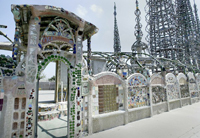 Watts Towers may get LACMA as a guardian
Watts Towers may get LACMA as a guardian
The art museum offers to direct conservation work on the fragile structures that has been delayed by Los Angeles' budget crisis.Los Angeles' budget crisis has delayed important upkeep on the Watts Towers. (Robert Lachman / Los Angeles Times)
The Los Angeles County Museum of Art is interested in stepping into the breach as curator and conservator of the Watts Towers starting this summer as a severe budget crisis saps the city of Los Angeles' ability to continue those functions.Olga Garay, executive director of L.A.'s Department of Cultural Affairs, said she had "a very encouraging meeting" Monday with two top museum officials, LACMA President Melody Kanschat and general counsel Fredric Goldstein, over enlisting the museum's know-how and fundraising connections on behalf of a national historic landmark that's owned by the state and operated and maintained by the city. Garay's department has been perpetually short of the cash needed for the Sisyphean task of reattaching bits of ornamentation washed off by the rain and filling internal cracks caused by moisture and heat. Under the plan, LACMA would contribute its expertise and direct the conservation work, Kanschat said. It would still be up to the city to pay for manpower and materials, which Garay expects will be budgeted at $100,000 to $200,000 in city funding in the coming year. "This is really about understanding how important this icon is and how important the artwork is," Kanschat said. "We really want to step in and help and make sure that the artwork is well cared for."First, she said, LACMA staffers will have to look at past studies and recommendations. Barring any problems, Kanschat said, she, Goldstein and LACMA Director Michael Govan, an avowed fan of the Watts Towers, will "try to make it happen by July 1." Kanschat said that LACMA also would lend "our influence and some of our connections" to help raise private donations for Watts Towers conservation. LACMA staff also would review how the towers are operated and marketed, with an eye toward boosting visitation, which totaled 44,112 in 2008-09. Guided tours cost $7. Garay reported to City Council members last July that she was then "very early in the exploratory stages" of talks with both LACMA and the Getty Conservation Institute branch of the J. Paul Getty Trust about forming partnerships to address the towers' needs. At the time, she said, a "quick and dirty" estimate put the cost at $5 million to carry out deferred conservation work and put the towers in prime shape. Garay said her department continues to "have a good working relationship with the Getty" and hopes to draw on its conservation expertise; on another front, she said, the Getty has granted the Department of Cultural Affairs $156,000 to research an exhibition on the role the Watts Towers Arts Center and the Municipal Art Gallery played in nurturing Los Angeles artists during the 1960s and 1970s. It will be part of the Getty-funded "Pacific Standard Time: Art in L.A., 1945-1980," a collaborative project by 26 regional arts institutions that will mount exhibitions on the theme in 2011. L.A.'s municipal budget crisis has hastened the need to find help just to continue the partial measures that have been the rule. Because of layoffs, a hiring freeze and an early retirement plan aimed at trimming city employment rolls, the Department of Cultural Affairs expects to see its staffing reduced from 70 positions to 37 by July 1. Among the employees being lost to early retirement, Garay said, are Virginia Kazor, longtime curator of the Watts Towers and another historic landmark, Hollyhock House, which architect Frank Lloyd Wright planted on a Hollywood hilltop in 1921. The towers, topping out at just under 100 feet high, were created single-handedly by Simon Rodia, an uneducated Italian immigrant stonemason who built them in his spare time from 1921 to 1954. He created the framework of steel, wire and concrete and ornamented the three main spires and their 14 surrounding sculptural elements with colorful bits of broken glass, pottery and seashells.Especially after they were left untouched during the 1965 Watts riots, the towers gained symbolic heft as an emblem of resilience, individual initiative, underdog achievement and potential rebirth. Periodically, pots of money have come from state or federal sources to undertake larger repair projects -- most recently a $569,000 payment from the Federal Emergency Management Agency in 2008 to repair storm damage.But the conservation process has slowed to a near stop: The city's tower conservator has been on medical leave for most of the past few months, Garay said, and a workman who does the hands-on replacing of fallen ornaments has had to spend most of his time at Hollyhock House. California is the towers' owner and has a 50-year agreement with the city to act as the site's caretaker and operator. Sean Woods, the state parks superintendent for the Los Angeles sector, said Monday that there's no immediate plan to crack down on the city for the recent lapses in upkeep, given its fiscal problems. Woods said that a city partnership with LACMA on towers conservation "could bring a whole array of benefits." Another employee who Garay said will be lost to early retirement is Mark Greenfield, former director of the Watts Towers Arts Center and now director of the Municipal Art Gallery next to Hollyhock House in Barnsdall Park.The gallery's curator, Scott Canty, will remain, but Garay said she also is exploring making the 10,000-square-foot space available to local museums as a site for exhibitions that their staffs would curate. Jeffrey Deitch, the incoming director of L.A.'s Museum of Contemporary Art, has visited the site, Garay said.
 Watts Towers may get LACMA as a guardian
Watts Towers may get LACMA as a guardian